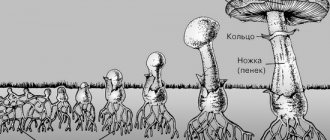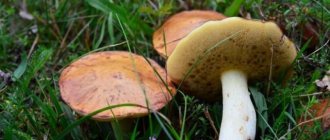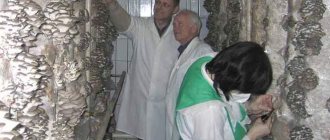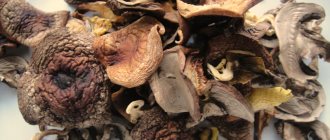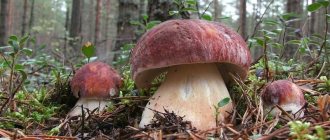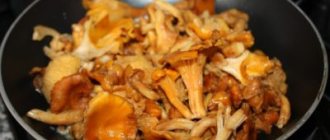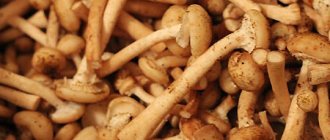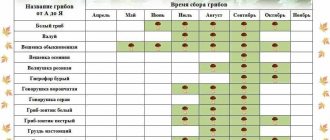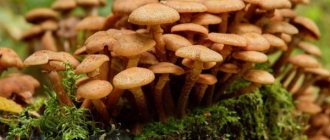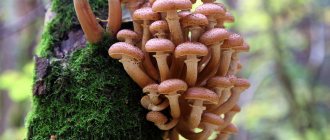The growth conditions for porcini mushrooms have their own specific nuances. Therefore, when going to the forest, every mushroom picker should know what kind of weather these fruiting bodies like and what temperature they prefer most.
Note that the mycelium of porcini mushrooms grows from early spring until the end of autumn. The growth of porcini mushroom depends on a constant flow of air, humidity and a certain temperature. The mycelium penetrates the top layer of soil to a depth of 15 cm. If drought or excessive moisture lasts for a long time in places where the porcini mushroom grows, as well as soil compaction or early frosts, the fruiting bodies develop very poorly and the mycelium becomes dehydrated. Therefore, for good growth of mushrooms, air humidity and heat are needed, especially in the ground layers.
Air humidity and temperature for the growth of porcini mushrooms after rain
The growth rate of porcini mushroom will be good only at a relative air humidity of up to 60%. If a drought occurs suddenly after the rainy season, the fungus stops growing, even if there is enough moisture in the soil. The fruiting body of the porcini mushroom is not protected from evaporation, so at low air humidity it dries out. Mushroom pickers with extensive experience know that you need to look for porcini mushrooms under moss or in the forest floor.
The second important factor influencing the growth of porcini mushroom is temperature, which will also affect the growth of mycelium and the growth of spores. It must be said that spores can grow at low temperatures, for example at + 8°C.
The optimal air temperature for the growth of porcini mushrooms is from +18 to +28°C. Fruiting bodies grow especially quickly in rainy, warm weather; their growth can continue for a whole month. The average weight of a mushroom during this period is up to 250 g. Already on the fourth or fifth day, the average weight of a young mushroom can reach up to 150-180 g. And after the rains, the growth of porcini mushrooms only increases: sometimes mushroom pickers find boletus mushrooms up to 10-12 cm long with large caps with a diameter of up to 15-18 cm.
Boletus mushrooms (also called porcini mushrooms) live up to 12-14 days. First, the stem stops growing, and after 2-3 days the cap stops growing. As soon as spores begin to form, the fruiting bodies of the porcini mushroom quickly age.
Where porcini mushrooms grow is an important condition for good harvests. These fruiting bodies can grow for several years in a row in one place. However, this condition will depend on how you treat the mycelium itself. Therefore, beginning lovers of “silent hunting” must learn that the stems of porcini mushrooms must be carefully cut off with a knife, leaving the lower part in the ground so as not to damage the future harvest. Next year, when picking mushrooms, you will definitely find boletus mushrooms in the old places.
The growth time of porcini mushrooms depends on the climatic conditions and latitudes in which the forests are located.
In the greenhouse
Porcini mushrooms can be successfully grown in a barn
Any room with proper conditions is suitable for propagating porcini mushrooms in a greenhouse. This could be a barn, basement, cellar, greenhouse or hangar.
Preparing the site
To successfully plant this type of house, it should provide two conditions:
- temperature within 8-12 °C;
- high air humidity at 85-90%.
Such a room must have good ventilation, which is necessary for intensive growth of the porcini mushroom.
During the incubation period, the mycelium does not need light, but during the appearance of fruiting bodies, the plantings are provided with daylight for 5 hours. The main thing is that the light is not too bright, otherwise the mycelium will simply dry out.
Preparation of material
With this method, ready-made planting material is used, intended for the Dutch method of growing mushrooms. The Dutch have developed a unique method in which mushroom growers get the best yields when growing crops indoors.
“Wild seedlings” will not give such results and their survival rate is quite low. The process of preparing for planting is the same as when planting on the site.
Landing rules
Porcini mushrooms are planted in greenhouse conditions in several ways:
- in the beds;
- in bags;
- in boxes.
By the way. Some people successfully grow this mushroom in apartment conditions.
The process of planting and preparing a planting hole in greenhouse conditions is no different from the natural method of growing mushrooms. The main thing is that in such a room all the above conditions are met.
In the basement, barn or cellar, bags or boxes are used for planting mycelium. It will grow especially well in wooden (eco-friendly, “breathable” containers) boxes. A wooden container is filled with a pre-sterilized mixture of hay, corn cobs, sawdust, seed husks and buckwheat. First there is a layer of substrate, then a layer of mycelium, again a layer of substrate, and so on, alternating until the very top. The top layer must be a planting mixture. The same principle applies to planting in bags. After planting, holes are made in them.
Attention! If you are planning long-term plantings of mushrooms, then it makes sense to treat the tree with special preparations that prevent rotting, for example, Pinotex or Belinka.
Boxes and bags are placed on racks at a distance of 15 cm from each other.
Care
During the incubation period, the plantings are kept warm at a temperature of 23-25 ° C without additional lighting. When the first caps appear, the temperature is reduced to 10 ° C (it is subsequently maintained at this level, thus forming a certain temperature regime) and good ventilation of the room is ensured.
During the process of growth and development, mushrooms are regularly sprayed with a spray bottle - morning and evening. Light is needed daily for 5 hours.
Porcini mushrooms begin to be collected 20-25 days after the young caps appear.
Favorite places to grow porcini mushrooms
These forests are considered the most characteristic landscape for the growth of porcini mushrooms.
These fruiting bodies have a brown cap and stalk and prefer sandy or loamy soil. In spruce-fir forests, boletus mushrooms grow on moss-lichen bedding, which mushroom pickers call “a real porcini mushroom.” Deciduous forests. There are much fewer such forests in Russia than pine forests. However, you can also find porcini mushrooms in them. Birch forests or birch groves are considered the favorite place for the growth of porcini mushroom. The fruit bodies in these places have a lighter shade of the cap and stem, as well as a more pleasant taste of the pulp. Prefers boundaries between overgrown and open areas, as well as edges and well-lit clearings.
Mixed forests. In these forests you can often find clusters of porcini mushrooms. This may be influenced by the original undergrowth of mixed forests. In addition, birch often grows in them, which can provide high yields of boletus.
Porcini mushrooms grow in forested areas all over the world, except Antarctica and Australia. As we have seen, they grow in deciduous, pine and mixed forests. These fruiting bodies have conquered almost all of Europe, North and South Africa, Central America, Turkey, China, Japan, Siberia and the Far East. In forest-steppe zones, the abundance of porcini mushroom growth noticeably decreases, but the boletus disappears completely when moving to the steppe zone.
Knowing the favorite places for the growth of the porcini mushroom and the time of its fruiting, you can safely go into the forest and look for these amazingly tasty and aromatic fruiting bodies. Having found such places, carefully cut off the legs with a knife so as not to damage the mycelium. In the coming years, you will definitely collect more than one basket here.
What mushrooms can you pick now? Mushrooms growing in September
Mushrooms grow in September in deciduous, coniferous and mixed forests. They are found in artificial forest plantations.
Before picking mushrooms in September, you should understand the varieties and names, and also understand which mushrooms can be collected and which ones should be discarded.
There are a large number of varieties of all mushrooms. There is no general world classification. On the territory of Russia they are divided into 4 categories:
- maximum value;
- less nutritious and tasty;
- with mediocre taste;
- low-value, with weakly expressed taste qualities.
Type 1 includes porcini mushrooms, boletus mushrooms, saffron milk caps and yellow milk mushrooms. The most favorable regions for collecting such mushrooms are the Tula region and the Moscow region.
Category 2 includes boletus, boletus and champignons. They have significantly less nutritional value.
The 3rd category in Russia includes edible mushrooms with average nutritional value and taste (moss mushrooms, russula and honey mushrooms). In the Voronezh and Belgorod regions, russula and milk mushrooms are collected in the fall. In the Altai Territory, they are less common in September; they are collected in the summer months.
In the 4th category there are living organisms with a unique taste and low calorie content (oyster mushrooms, puffballs or motley mushrooms).
According to their edibility, September mushrooms, like all others, are divided into the following groups:
- edible;
- conditionally edible;
- inedible;
- poisonous.
This classification is based on safety for consumption and ease of preparation. It is impossible to get poisoned by edible mushrooms, even if they are raw.
Conditionally edible ones cannot be eaten raw. They taste bad. They are pre-soaked, then boiled or dried.
Safe for human health, but tasteless, inedible mushrooms. They are not used in cooking.
In poisonous organisms, toxic substances cannot be removed by simple cooking techniques at home. Eating them is life-threatening.
Seasonal characteristics of mushroom growth
Fungi are complex organisms. Their main part - the mycelium or mycelium - is hidden from view by a layer of forest humus, and only fruiting bodies appear on the surface, which attract mushroom pickers. Mycelium grows all year round, so it is not easy to answer the question at what temperature mushrooms grow in autumn.
Along with humidity, one of the most important conditions for fruiting for most species is warm soil. Therefore, the first mushrooms appear in the spring. In April-May, when clearings, clearings and forest burnt areas freed from snow warm up, morels and stitches appear. They are the ones who open the mushroom season, and then other mushrooms pick up the baton.
Towards the end of May and early June, after warm rains, the first moss mushrooms, boletus mushrooms, and even white ones appear. But these are only scouts; the main layer will appear later, when the rye begins to sprout. By the way, these mushrooms are popularly called spike mushrooms.
Aspen boletuses, or as they are also called, krasoviki, redheads, appear a little later, when the aspen has faded. At the same time, colorful caps of russula peek out from the grass, and cheerful flocks of chanterelles scatter in the moss, like orange beads.
But the summer layers are short - a week, two at best, and the mushrooms disappear as if they never existed. But the real mushroom will only grow in the fall, when the braids of the birches begin to turn golden and splash crimson on the foliage of the aspens.
Mushrooms of the autumn forest
In autumn, almost all types of summer mushrooms grow, but new ones also appear, those for which it is too hot in summer. These are, for example, autumn honey fungus, greenfinch, row and others. Moreover, in the fall, the growth of mushrooms is the most intense, since they do not like heat, and in order for the fruiting body of most species to begin to develop, 5–10 o C is enough. The temperature at which mushrooms grow in the fall affects the speed of their development: how The lower the degree, the slower they grow.
However, not only temperature indicators matter, but also humidity. If autumn is dry, then you can’t count on a good “catch” of mushrooms. However, they don’t like prolonged rains either. An experienced mushroom picker will look at how the next bad weather splashes on the roads in puddles, and sigh sadly: “Eh, the mycelium will get wet!” The mycelium, of course, will not get wet, it will remain under the dense forest floor of fallen pine needles and moss, but there may indeed be no mushrooms.
But light frosts, which are not uncommon in autumn, are not scary for mushrooms. Sometimes on a cold October morning in the forest you can find boletus, boletus, redhead, boletus, and honey mushrooms literally frozen through. When determining at what temperature mushrooms grow in the forest in the fall, you should focus on average daily values, since warming up the soil during the day plays an important role.
When the frost hits
Few of these forest dwellers can survive severe frost, and most mushroom pickers believe that the season ends in November. But that's not true.
One of the most cold-resistant mushrooms is honey mushrooms. The best temperature for their growth varies in the range of +8. +12 o C. Their cheerful families grow in the forest even after serious frosts. At what temperature do mushrooms grow in autumn? Winter honey mushrooms, for example, can be found at sub-zero temperatures, even under snow.
Winter oyster mushrooms are also not afraid of frost, which can be harvested not only in November, but also in January.
Fruiting time for different species
Winter, summer, living in pine forests or deciduous forests, growing on tree trunks or directly on the ground - there are really many varieties of mushrooms, and there are many differences in their development. However, scientists were able to classify the most common and popular types into two groups, conditionally dividing them into:
- Fast-growing varieties that can add 1.5 cm in one day, appearing immediately after precipitation. In addition, the low location of the mycelium allows representatives of this species to grow quickly, forming entire colonies. These include champignons, saffron milk caps, fly mushrooms, russula, aspen mushrooms, and boletus mushrooms.
- Slow-growing species, the maximum daily growth of which does not exceed 3 mm when appearing 5-7 days after rain. Their dense structure prevents these mushrooms from gaining more impressive rates, but their taste is excellent. So, representatives of this type are boletus, chanterelles, morels, milk mushrooms and delicious inhabitants of the underground - truffles.
Advice! Mushroom pickers should wait a few days after the rain, since then there is a high probability of finding a large number of both fast-growing species and slowly developing mushrooms. The only obstacle is more vigilant mushroom pickers who can manage to collect all the “cream”.
Conditions for the growth of porcini mushrooms
No matter how full the mushroom picker’s basket is, his luck is judged primarily by the number of porcini mushrooms.
White, or, as it is also called, boletus, is a cunning and finicky mushroom. Sometimes you have to go around half the forest to attack a mushroom place. But if the conditions are suitable, then even in a small patch you can collect more than a dozen strong boletus.
At what temperature do porcini mushrooms grow in the fall? Firstly, we note that for white it is not so much the condition of the air that is important as the condition of the soil. The optimal soil temperature for it is 15–16 degrees Celsius.
When to collect boletus mushrooms in the fall
Boletus mushrooms, especially young and strong ones, are in no way inferior to white ones - even boiled, dried, or fried. And if they go in layers, then you can collect more than one bucket of them in a relatively small forest.
According to popular belief, the first boletuses appear when the mountain ash blooms, and then they do not leave forest glades and birch groves all summer. Unless, of course, the summer was too hot and dry. But the summer boletus has one drawback - the worm really loves this tasty mushroom. So the mushroom picker has to reluctantly throw away one mushroom after another.
In autumn, boletus flowers are clean and strong. And besides, their special appearance appears - with a thick stem and a dark cap, the taste is practically no different from the white one. Finding it, however, is not easy in the fallen leaves. But if you come across one, then you can find a dozen more around it.
At what temperature do mushrooms grow in autumn (boletus mushrooms)? Their temperature regime is almost the same as that of whites. For boletus, 10–12 degrees Celsius is quite enough, only these mushrooms love wetter weather, not prolonged rains, but thick autumn fogs. And if the autumn is dry, then boletus mushrooms should be looked for in damp places, in lowlands and even in a swamp.
A good mushroom picker knows at what temperature mushrooms grow. In the fall, in the forest, he will quickly fill a basket, or even take out a bag - don’t leave boletus and boletus, aspen and boletus, milk mushrooms and capillaries under the fir trees and birches! And if honey mushrooms attack, there may not be enough packages.
Fungi, like all living organisms, require certain conditions for their growth and development. The most important criteria are humidity and air temperature. Lighting is less important for these organisms.
However, these figures are not strict, since each type has its own limits. Knowing the growth temperature of mushrooms is necessary not only for those who grow them, but also for those who like to collect them in the forest. This information will allow you to choose the optimal day when you can harvest the maximum harvest.
The most suitable time for collecting mushrooms is the period that lasts from the beginning of spring and ends with the arrival of frost. Therefore, if there have not been the first frosts yet, then in winter you can go on a “quiet hunt”.
When the mushrooms start growing 2022. Forest and meadow honey mushrooms - the summer picking season is open!
The season for collecting forest and meadow mushrooms opens in July. So 2022 was no exception to the rule! Many mushroom pickers have already visited forest areas and collected several kilograms of mushrooms. And even despite the fact that summer mushrooms are inferior in popularity to autumn mushrooms, professional mushroom pickers who know a lot about taste and aroma do not miss the chance to go on a quiet hunt.
Honey mushrooms 2022 are the most delicious and convenient fruits for mushroom pickers. Their indescribable taste, captivating aroma and group growth method allow you to harvest in a short time. To find several families, just take a leisurely walk through the forest, enjoying the beautiful scenery and clean air saturated with oxygen.
The beginning of the harvest is considered to be rainy but warm weather. At this time, the soil is saturated with moisture, allowing the mycelium to germinate in the tree trunk. As mushroom pickers say, if it rains well, in 5-6 days a silent hunting competition between mushroom pickers will begin in the forest.
If experienced mushroom pickers know where mushrooms grow and when the mushroom picking season begins, beginners can only trust the information provided on the Internet. Therefore, in order not to waste time, before hunting you should carefully consider the comments on forums and social networks dedicated to mushroom picking. You can get the most out of them:
1) find out where mushrooms grow, down to location; 2) find out whether mushroom picking has begun; 3) where there are more honey mushrooms.
Temperature required for mushroom growth in autumn
This time of year marks the peak of the mushroom season. In autumn you can find almost all summer species, but new ones also grow - exclusively autumn fungal representatives. The very first to stop growing are porcini and oak mushrooms - as soon as the temperature drops below 15 degrees, the development of these species stops. Then in the forest the number of moths, russula, flywheels and scales gradually decreases. These species stop growing when the atmospheric temperature drops to 10 degrees.
The most common species found in the forest at this time of year is the autumn honey fungus.
They prefer dampness and old wood as a growing environment, so you need to look for them in ravines and on stumps. The most favorite plants of the autumn honey mushroom are poplar and mulberry.
Greenfinch has greater resistance to cold.
It can grow at a temperature of 5 degrees Celsius. People also call it the harbinger of winter: as soon as the greenfinch appears in the forest, it means that frost will hit in two weeks. Greenfinch prefers pine forests with sandy soil. Grows in well-lit clearings and paths. It practically does not grow alone, so you can collect almost a full basket from one plot.
Favorable temperature conditions in spring
As soon as the snow melts and the air temperature rises to 5–10 degrees Celsius, morels can be found in the forest.
Very often they are found right in melt puddles. Another favorite place for their growth is the space near deciduous trees.
Along with the morels, lines appear.
The common species prefers to grow under coniferous trees. However, giant stitch is found mainly in mixed and deciduous plantings. When harvesting the mushrooms listed above, be careful, as they are conditionally edible. They can be consumed only after preliminary heat treatment.
Another type of mushroom that can be found in the spring forest is the puffball. But it appears later than strings and morels, when the ambient temperature remains stably above 15 degrees Celsius.
In addition to heat, this mushroom requires excess moisture to grow. Therefore, it is mainly found in May after rain. Widely distributed in coniferous and mixed forests. When harvesting puffballs, you need to pay attention only to young mushrooms. They represent the greatest nutritional value, because, unlike old mushrooms, they have soft flesh.
In the spring, mushroom pickers often find orange petitsa in the forest.
Apart from its attractive color, this mushroom does not stand out in any way. It has no mushroom smell or taste. It is mainly used as a bright element in dried bundles.
In the garden
Growing porcini mushrooms on the garden plot is carried out in several stages.
Preparing the site
Preparatory work on the site begins with:
- Growing location definitions: sunny place with slight shade.
- Search for individual tree species on the site: determining which mushroom grows with in the forest. Therefore, they should provide the same neighborhood at home. Planting is done in the spring.
- Cleaning and watering: About a month before planting, the place selected for the mushroom bed should be cleared of weeds and garden debris and watered daily.
- Substrate preparation: it is worth preparing crushed tree bark and dry leaves in advance. Both components are added to the soil when planting mushrooms.
Harvesting "seedlings"
Porcini mushrooms are collected for planting in a pine or mixed forest. When choosing mushrooms for “seedlings”, you should follow some rules:
- You need to collect only those mushrooms that grow under the same trees as in your garden. Preference is given to the densest and largest specimens.
- After the harvest has been harvested, it should be immediately processed - separate the caps from the stems and chop the caps.
- Next, a special solution is prepared from settled water (without chlorine, leave for at least 24 hours), several crystals of potassium permanganate (pale pink solution) and 10 pieces of refined sugar.
- The crushed raw material is kneaded to a mushy consistency, poured with this solution, mixed and left for a day.
- Then filter through cheesecloth. The solution with spores is evenly spilled over the bed, the remaining raw materials in the gauze are evenly laid out on top of the substrate.
Many mushroom pickers use “wild seedlings”. To do this, dig up a section of mycelium (approximately 25x25 cm), transfer it to the planned planting site and dig it in.
Gardening stores sell ready-made seed material.
Landing technique
In the prepared area, a hole is dug about 30 cm deep and about 3 m² in area. The dug soil is thoroughly mixed with humus. The bottom is sprinkled with crushed bark and dry leaves (there should be an even layer over the entire surface of the bottom of the pit).
Planting materials are mixed with sand and evenly scattered onto the bark and leaves. Then cover with a small layer of compost. The final layer is a mixture of garden soil and humus. This type does not require a lot of moisture, so you should not water it every day. It is enough to carry out light irrigation as the top layer of soil dries. With the onset of cold weather, plantings are sprinkled with snow, fallen leaves or moss.
When planting in spring, the first harvest is harvested in the fall. If planting was carried out in the fall, fruiting bodies are obtained only after a year.
Mycelium grown at home will produce stable yields for 5-7 years. Under good conditions, from an area of one hundred square meters it is possible to collect from 15 to 25 kg of mushrooms. Such cultivation is not difficult, but it is important to consider that mycelium does not always take root in such conditions.
Required temperature in summer
Summer is a favorable time of year for fungal growth, but extreme heat is detrimental to these organisms. When the atmospheric temperature rises above 35 degrees, the activity of the mycelium is inhibited. Therefore, if it has been unbearably hot all week without a single rain, then there is no point in going on a “quiet hunt” - there will be nothing to collect. The optimal combination for mushroom growth is recent rain and temperatures around 20 degrees.
Under favorable conditions, boletuses are among the first to appear.
They grow mainly in deciduous and mixed green spaces. They love shade very much, so you need to look for them in thickets and moss.
Then the boletus begins to grow actively.
Different types of butterfly prefer different conditions, some require coniferous forests, and some are suitable for deciduous forests. Therefore, they can be found everywhere, mainly in well-lit clearings.
In mid-summer, a large number of porcini mushrooms appear in the forest.
Porcini
This species prefers to grow in pine and birch forests in open areas well lit by the sun. They rarely grow alone, so if you find one, then most likely there are at least a couple more porcini mushrooms nearby.
Even in the summer you can find wavefish.
Most often they grow in birch forests, but they can also be found in mixed forests. Experienced mushroom pickers recommend collecting only young fruits, as they have a dense cap and tolerate transportation well.
Dubovik is also mainly harvested in the summer. The peak of its growth is observed at the beginning and end of summer, since this mushroom does not tolerate extreme heat. Most often it is collected near oak or linden, so it is necessary to “hunt” for it in deciduous forests.
At what speed do milk mushrooms grow? How long does boletus grow after rain?
The mycelium of the boletus is located almost on the surface, i.e. under the top layer of soil - at a depth of 10-15 cm. Therefore, good rain and warm sunny weather are needed. Only under such conditions will the mycelium grow.
Oilseeds are collected in young coniferous forests, as well as in open, well-lit clearings. They grow in large families, which allows you to collect a whole basket in one place. An important role for mushroom picking is played by how much boletus grows after rain.
It is worth noting that boletus on a good mycelium after rain begins to grow the very next day. If a mushroom picker wants to collect strong young boletus, then you should go “hunting” after 12-18 hours.
How long it takes boletus to grow after rain depends on the condition of the soil, lighting, air temperature, etc. On average, 2-3 days are enough to reach full maturity of the mushroom. But do not forget that boletus mushrooms are “fast” mushrooms, which means they will also begin to spoil quickly. The most important thing here is to correctly calculate the moment of going into the forest.
Popular articles How to replant an orchid: step-by-step instructions at home
Every mushroom picker knows that the main harvest of boletus occurs in August, September and early October. Therefore, how long boletus mushrooms take to grow depends on two main factors. The first, as already mentioned, is well-moistened soil, and the second is a warm and sufficiently illuminated upper layer of the mycelium.
Many knowledgeable mushroom pickers claim that it takes very little time for an oil can to rise from the ground. So, how long does the butterfly mushroom grow after warm rain? 5-7 hours are enough, and a young, clean, small mushroom appears in the basket. By the way, it is precisely these butters that are highly valued for marinating in jars because they have a beautiful appearance and the appropriate size.
As you can see, in order to correctly determine how much an oil can grows, it is necessary to take into account weather conditions and the characteristics of the local climate. They must be suitable, because even after heavy rainfall, boletus may not appear. Sometimes it happens that there is a lot of moisture, but there is no sunlight and heat. Or the soil is poorly saturated with moisture, and the sun greatly heats the air and the mycelium dries out.
To what temperature can mushrooms grow during the first frost?
Very few types of mushrooms can withstand the cold. Therefore, for most lovers of “silent hunting”, the mushroom season ends with the arrival of November. But this is not entirely reliable. Since there are species that grow exclusively after the first frost.
A striking representative of frost-loving mushrooms is the winter honey fungus.
It grows mainly in deciduous forests on trees. In addition to their bright appearance, they have excellent taste, so hunting for them makes sense. The mycelium does not grow directly in sub-zero temperatures, but frost only slows down its growth and does not stop it. Therefore, when it gets a little warmer, the winter honey fungus thaws and continues to grow.
Another mushroom that can be found in winter is the winter oyster mushroom.
It likes to grow on dried aspen and birch trees. It is extremely rare in other species.
